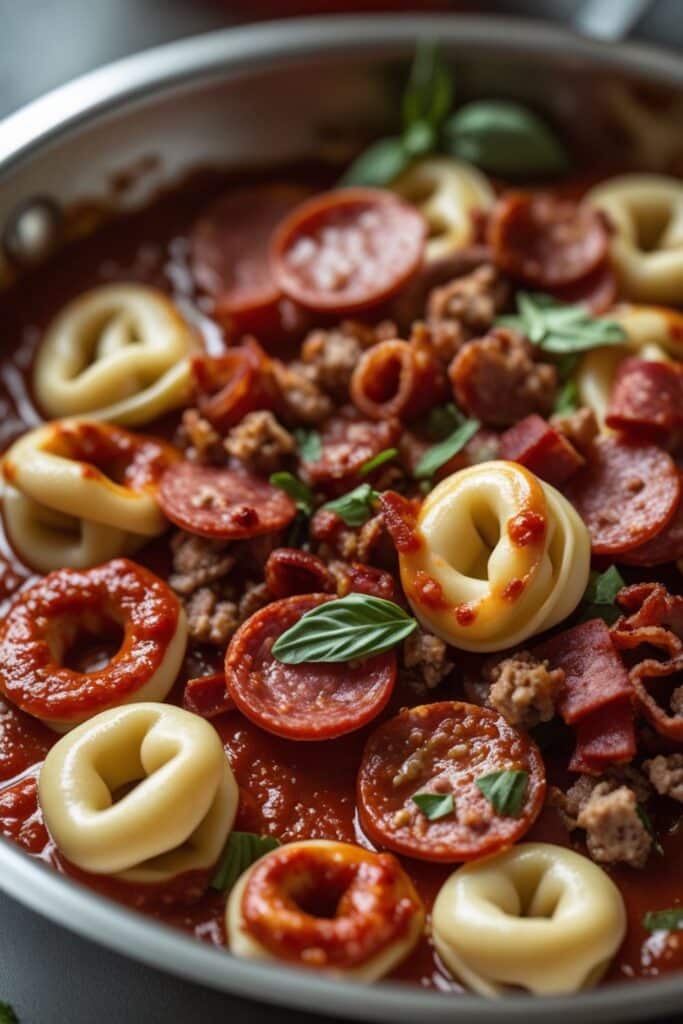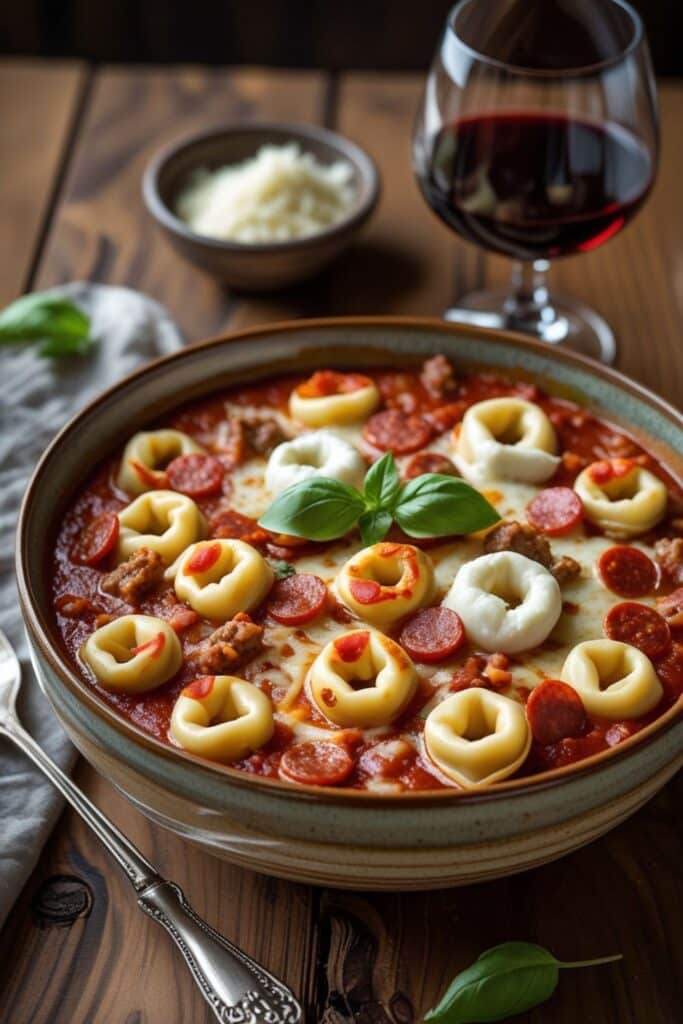Picture this: it’s 2 AM, you’ve just finished a brutal dinner service, and you’re standing in your kitchen staring at leftover pizza toppings and a bag of fresh tortellini.
What sounds like a fever dream actually became one of my signature dishes after that exact moment of exhaustion-fueled inspiration. Sometimes the best recipes are born from pure necessity and a refusal to waste good ingredients.
Meat Lovers Pizza Tortellini isn’t just fusion food it’s comfort food evolution. This dish takes everything we love about a loaded pizza and transforms it into a pasta experience that delivers twice the satisfaction.
The marriage of Italian pasta tradition with American pizza excess creates something entirely new, yet familiar enough to feel like home.
What makes this recipe special isn’t just the novelty factor. It’s the way the rich, cheese-filled tortellini absorbs the bold flavors of Italian sausage, pepperoni, and bacon while swimming in a sauce that bridges marinara and pizza sauce.
The technique required here goes beyond simple combining it’s about layering flavors, managing textures, and understanding how different proteins interact with pasta and sauce.
Ingredients & Substitutions
For the Pasta Base:
- 1 pound fresh cheese tortellini (or 12 oz dried)
- 2 tablespoons kosher salt (for pasta water)
- 1 tablespoon olive oil
For the Meat Mixture:
- 8 oz Italian sausage, casings removed
- 6 oz pepperoni, diced into quarter-inch pieces
- 4 strips thick-cut bacon, chopped
- 1 small yellow onion, finely diced
- 4 cloves garlic, minced
- 1 red bell pepper, diced (optional but recommended)
For the Sauce:
- 24 oz marinara sauce (preferably San Marzano-based)
- 2 tablespoons tomato paste
- 1 teaspoon dried oregano
- 1 teaspoon dried basil
- 1/2 teaspoon red pepper flakes
- 1/4 cup red wine (optional)
- Salt and black pepper to taste
For Assembly:
- 1 cup whole milk mozzarella, shredded
- 1/2 cup Parmesan cheese, freshly grated
- 1/4 cup fresh basil leaves, torn
- 2 tablespoons butter
The beauty of this recipe lies in its flexibility. Can’t find fresh tortellini? Dried works perfectly, though you’ll need to adjust cooking times. The key is choosing a cheese-filled variety ricotta, three-cheese, or even spinach and ricotta all work beautifully.
For the meats, quality matters more than precision. If you can’t source good Italian sausage, substitute with ground pork seasoned with fennel seeds and red pepper flakes. Turkey pepperoni works for those watching fat content, though you’ll lose some of that characteristic tang. The bacon should be thick-cut to hold its texture against the other bold flavors.
San Marzano marinara isn’t just chef snobbery the acidity level and sweetness balance perfectly with the rich meats. However, any good-quality marinara will work. Avoid anything with too much sugar or additives that might compete with your carefully built flavor profile.
Step-by-Step Instructions

Preparing the Foundation
Start by bringing a large pot of water to boil. Use more water than you think you need tortellini requires room to move freely. Add salt generously; the water should taste like mild seawater. This is your only chance to season the pasta from within.
While the water heats, begin building your flavor base. In a large, heavy-bottomed pan or Dutch oven, cook the bacon over medium heat until it renders most of its fat but still retains some chew. Remove with a slotted spoon, leaving the rendered fat behind. This fat is liquid gold it’ll carry flavors throughout the dish.
Add the diced Italian sausage to the bacon fat. Break it up with your spoon, but don’t overwork it. Large, irregular chunks create better texture than perfectly uniform crumbles. Cook until the sausage develops a deep brown crust on most pieces, about 6-8 minutes. The fond building on the bottom of your pan is flavor insurance.
Building the Meat Layer
Push the sausage to one side of the pan and add the pepperoni. Let it render its oils and crisp slightly this takes about 3 minutes. The pepperoni fat will mix with the bacon fat, creating a complex base that no olive oil alone could achieve.
Add the diced onion and bell pepper to the empty space in your pan. Season lightly with salt and cook until the onion becomes translucent, about 5 minutes. The vegetables should soften but maintain some bite they’ll continue cooking in the sauce.
Create a well in the center of your meat and vegetable mixture. Add the minced garlic and cook for 30 seconds until fragrant. Garlic burns quickly in rendered fat, so watch carefully. When you can smell it, you’re done.
The Sauce Transformation
Add the tomato paste to the garlic and cook for another minute, stirring constantly. This step deepens the tomato flavor and removes any raw taste from the paste. The mixture should darken slightly and become fragrant.
If using wine, add it now and scrape up any browned bits from the bottom of the pan. Let it reduce by half about 2 minutes. The alcohol will cook off, leaving behind concentrated flavor that bridges the gap between the meat and the marinara.
Pour in the marinara sauce, then add the oregano, basil, and red pepper flakes. Return the cooked bacon to the pan. Bring to a gentle simmer, then reduce heat to low. The sauce should bubble lazily, not aggressively. Let it develop for 15-20 minutes while you handle the pasta.
The Pasta Perfection
Drop the tortellini into your boiling water. Fresh pasta cooks quickly usually 3-4 minutes. Dried tortellini takes 8-10 minutes. The pasta is done when it floats and the edges feel tender but still have slight resistance when bitten.
Here’s where many home cooks go wrong: they drain the pasta completely. Reserve at least a cup of pasta water before draining. This starchy water is your secret weapon for binding sauce to pasta.
The Final Assembly
Add the drained tortellini directly to your sauce pan. This is crucial finishing pasta in its sauce creates a cohesive dish rather than sauce-topped pasta. Toss gently to coat every piece.
If the mixture seems dry, add pasta water a tablespoon at a time until everything moves smoothly together. The sauce should coat the tortellini without pooling in the bottom of the pan.
Remove from heat and add the butter, stirring until melted. This step, called mantecatura in Italian cooking, creates a glossy, unified sauce that clings to every surface.
Cooking Techniques & Science

The magic of this dish lies in understanding how different fats interact with pasta and sauce. Bacon fat, sausage fat, and pepperoni oil each contribute unique flavors and textures. The key is controlling these fats rather than letting them overpower the dish.
When you render the bacon first, you’re creating a flavor foundation that will carry through every bite. The temperature matters here too high and you’ll burn the fat, creating bitter notes. Too low and the bacon won’t crisp properly, leaving you with chewy, unappetizing pieces.
The sausage browning phase is about the Maillard reaction those complex flavors that develop when proteins and sugars react under heat. Don’t rush this step. The deep, caramelized flavors you develop here can’t be replicated any other way.
Finishing pasta in its sauce isn’t just tradition it’s science. The starch released by the pasta acts as a natural emulsifier, helping the sauce cling to the tortellini. This technique ensures every bite has the perfect balance of pasta, sauce, and filling.
The butter finish serves multiple purposes. It adds richness, yes, but more importantly, it creates a stable emulsion that prevents the sauce from breaking or becoming greasy. The butter also adds a subtle sweetness that balances the acidity of the tomatoes and the saltiness of the cured meats.
Serving & Pairing Suggestions
Serve this dish in warmed bowls cold ceramic will shock the pasta and cause the sauce to congeal. A light dusting of freshly grated Parmesan adds both visual appeal and a sharp contrast to the rich, meaty flavors.
Fresh basil leaves torn just before serving provide a bright, aromatic counterpoint to the heavy meat and cheese. Don’t chop the basil tearing releases more essential oils and creates a more rustic presentation.
For wine pairings, consider a medium-bodied red like Chianti or Sangiovese. The acidity in these wines cuts through the richness while complementing the tomato base. If you prefer white wine, a crisp Pinot Grigio or Sauvignon Blanc works surprisingly well.
A simple arugula salad dressed with lemon vinaigrette provides necessary acidity and freshness. The peppery greens cleanse the palate between bites of the rich pasta. Crusty bread isn’t necessary this dish is substantial enough to stand alone.
Conclusion
Meat Lovers Pizza Tortellini represents everything great about fusion cooking when it’s done thoughtfully. It respects the traditions of both Italian pasta making and American pizza culture while creating something entirely new. The key to success lies in understanding that you’re not just combining ingredients you’re creating a harmony of flavors, textures, and techniques.
The most important lesson here is patience. Each step builds on the previous one, creating layers of flavor that can’t be rushed. From properly rendering the bacon to finishing the pasta in its sauce, every technique serves a purpose in the final dish.
Don’t be afraid to make this recipe your own. Add mushrooms for earthiness, substitute different cured meats based on what you have available, or experiment with different tortellini fillings. The foundation techniques will carry you through any variation.
Remember: great cooking isn’t about following recipes blindly it’s about understanding the why behind each step. Once you grasp the principles at work here, you’ll find yourself adapting and improvising with confidence.
Frequently Asked Questions?
Q: Can I make this dish ahead of time?
A: Partially, yes. You can prepare the meat sauce up to two days in advance and refrigerate it. However, cook the tortellini fresh and combine everything just before serving. Reheated pasta often becomes mushy and the sauce may separate.
Q: What if I can’t find fresh tortellini?
A: Dried tortellini works perfectly well, though the texture will be slightly different. Increase the cooking time according to package directions and reserve extra pasta water dried pasta releases more starch and may need more liquid for proper sauce consistency.
Q: How do I prevent the dish from being too greasy?
A: The key is controlling the fat throughout cooking. Don’t add extra oil when you already have rendered fat from the meats. If the finished dish seems greasy, add a splash of pasta water and toss vigorously the starch will help emulsify the excess fat.
Q: Can I substitute the meats for healthier options?
A: Absolutely. Turkey sausage, turkey pepperoni, and turkey bacon all work well. You may need to add a tablespoon of olive oil to the pan since these leaner meats won’t render as much fat. The flavors will be slightly different but still delicious.
Q: How do I store leftovers?
A: Store in the refrigerator for up to three days. When reheating, add a splash of water or broth to prevent the pasta from drying out. Heat gently over low heat, stirring frequently. The microwave works but may create uneven heating and rubbery pasta.

Veronica is a passionate food enthusiast with over three years of experience in exploring and writing about diverse cuisines. Her expertise lies in reviewing restaurants, sharing creative recipes, and discovering the latest food trends. As the voice behind FoodieRecap.com, Anju brings fresh perspectives and culinary insights to her audience.
